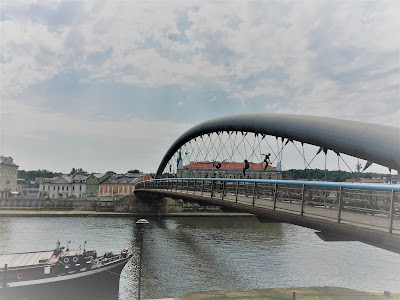 Kazimierz – also known as Krakow’s Jewish Quarter – is a 15-minute
walk from Krakow’s Old Town. For over
500 years, Kazimierz was a place of peaceful coexistence between the ethnic
Polish and Jewish communities and was the centre of Jewish life until the Nazis
took control of Poland.
Kazimierz – also known as Krakow’s Jewish Quarter – is a 15-minute
walk from Krakow’s Old Town. For over
500 years, Kazimierz was a place of peaceful coexistence between the ethnic
Polish and Jewish communities and was the centre of Jewish life until the Nazis
took control of Poland.
When the Nazis took control of Krakow, newly appointed
Governor General Hans Frank declared that Krakow would become the most
“racially pure” city in all of Europe and expunged all but 15,000 Jews from the
city. These remaining individuals were
forced from their homes into to the Jewish Ghetto located in the industrial
area on the other side of the river, far enough away to keep the rest of the
population “clean and safe”. One of the
notable residents was Roman Polanski who recounted his experiences there many
years later.
 The Ghetto was physically very small, with room for about
3,000 individuals versus the 15,000 that lived there. Without enough space inside the homes to
house everyone, many ended up living on the streets and, much like in Warsaw,
disease and illness ran rampant.
The Ghetto was physically very small, with room for about
3,000 individuals versus the 15,000 that lived there. Without enough space inside the homes to
house everyone, many ended up living on the streets and, much like in Warsaw,
disease and illness ran rampant.
 In the centre square of the Ghetto – now named Ghetto Heroes
Square – are 33 iron/bronze chairs – bringing to life a haunting photograph
that captured the Jews moving to the Ghetto and being forced to carry all of
their possessions – including chairs – on their person. Approximately 33,000 Jews perished in the
Krakow Ghetto.
In the centre square of the Ghetto – now named Ghetto Heroes
Square – are 33 iron/bronze chairs – bringing to life a haunting photograph
that captured the Jews moving to the Ghetto and being forced to carry all of
their possessions – including chairs – on their person. Approximately 33,000 Jews perished in the
Krakow Ghetto.
When all of the Jews had been moved to the Ghetto, a wall
was erected around it. In a symbolically
cruel gesture, the wall was designed in the shape of tombstones…and the construction
began right at the start of Passover, a time when the Jewish community
celebrates their liberation from slavery in Egypt.
 There are some stories of the Gentile resistance in Krakow, such
as Polish Roman Catholic pharmacist Tadeusz Pankiewicz, who obtained permission
from the German authorities to run the "Under the Eagle Pharmacy" and
treat the community living in the Ghetto.
And others, like Oskar Schindler, who although a controversial figure,
is also recognized with fighting for and saving the lives of 1,200 Jews by
employing Jews in his enamelware and ammunitions factories and paying off Nazi
guards in order to house them close to the factory and keep them safe. Schindler’s old factory is now a museum
tracing the horrors of WWII in Krakow.
There are some stories of the Gentile resistance in Krakow, such
as Polish Roman Catholic pharmacist Tadeusz Pankiewicz, who obtained permission
from the German authorities to run the "Under the Eagle Pharmacy" and
treat the community living in the Ghetto.
And others, like Oskar Schindler, who although a controversial figure,
is also recognized with fighting for and saving the lives of 1,200 Jews by
employing Jews in his enamelware and ammunitions factories and paying off Nazi
guards in order to house them close to the factory and keep them safe. Schindler’s old factory is now a museum
tracing the horrors of WWII in Krakow. After the war ended, the Jewish Quarter fell into disrepair
under Communist rule and became one of the city’s dodgiest districts.
After the war ended, the Jewish Quarter fell into disrepair
under Communist rule and became one of the city’s dodgiest districts.
In the 1990s, however, Steven Spielberg filmed Schindler’s List
in the Quarter, bringing new attention and life to the area. Tourists came from all around the world to reflect
and learn more, helping it to re-emerge as a bustling, bohemian neighbourhood
full of historical sites and atmosphere.
The Jewish Quarter was easily our favourite area of Krakow, with
quaint houses and uneven streets, innovative (and vegetarian!) restaurants and
an overwhelming feeling of warmth and authenticity.
And we are not alone. Many believe that Kazimierz is the European
city that conveys the most genuine sense of what pre-war Jewish and Polish life
was like, with synagogues and Jewish cemeteries still intact and houses similar
to what would have existed before the Nazis invaded.
While in the Jewish Quarter, we did our best to embrace
Jewish culture, eating at many Jewish-inspired restaurants and listening to a
live Klezmer performance, which was haunting yet warm and much more enjoyable
than we had anticipated. But in the back
of our mind, we knew this district wasn’t completely authentic – of the 60,000-80,000
Jews living in the city before the War, there are now only 700 that remain, far
smaller than the Quarter can accommodate and making the tragedy feel even more
real.



No comments:
Post a Comment